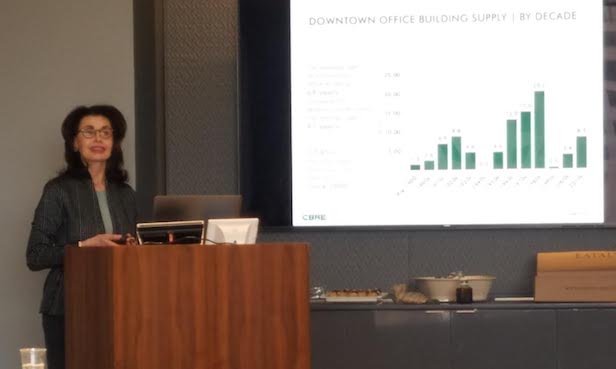 Mary Ann Tighe, CBRE's CEO, New York Tri-State Region
Mary Ann Tighe, CBRE's CEO, New York Tri-State Region
NEW YORK CITY—CBRE's CEO, New York Tri-State Region, Mary Ann Tighe made a compelling case for the future of Downtown Manhattan in a presentation to journalists last week at 3 World Trade Center. Like closing argument before a jury, Tighe conveyed a position that Downtown now offers a younger and larger building stock; less expensive options; spaces luring TAMI tenants; and a diverse community. Stated and unstated were comparisons to the competition of Midtown and Hudson Yards.
The average age of buildings in Manhattan is 77 years old. In Midtown South the average building age is 97 years old. “Interestingly, Downtown, where we know the city began, the average age is only 69 years,” said Tighe. “So, you have this curious thing where the oldest part of the city actually has the youngest supply of product.”
In addition, the average building size in Downtown of about 750,000 square feet dwarfs the average building size in Midtown South of 250,000 square feet.
It's not just newer product and larger floorplates. It's also less expensive.
Tighe set forth data for the last 10 years: Midtown South's rent growth has increased 102%. Rent in Midtown grew 40% and in Downtown it went up 58%. The average asking rents in Midtown South are $81.69. In Midtown they are $78.43 and Downtown they are $60.23.
CBRE charted a 23% price differential in asking rent comparing Downtown to Midtown and a 26% differential comparing the asking rent of Downtown to Midtown South. Plus, “There is always a discount Downtown. Always,” Tighe added.
Midtown South had been seen as a destination for tech companies, start-ups who preferred the older buildings as more affordable. With Wall St. Downtown was seen as a location for the financial industry.
But Tighe pointed out in the last 10 years, 524 companies have moved into Downtown and 100 have left. With TAMI (technology, advertising, media and information) tenants 28 moved out and 184 moved in. Downtown's professional demographics are shifting. Of the tenants leaving Downtown, 60% were those usually most associated with Downtown.
In the World Trade Center complex, 46% of the tenants are in the TAMI sector with 29% being in creative fields and 17% in technology, according to CBRE. “People would be astonished to realize that FIRE [finance, insurance, real estate] is 26%,” at the World Trade Center, said Tighe. CBRE research also indicated that the WTC buildings house 31 tech companies, occupying 1.2 million square feet of space.
New Yorkers have acknowledged affordability is becoming a problem for the city. Tighe's final point perhaps addressed an unspoken comparison to the criticism of Hudson Yards as being too expensive and exclusive. “Downtown has become the authentic New York City,” she said.
She noted the diversity of architecture. There are buildings dating back to the 17th century. Others have opened in the last 24 months. She pointed out there are rents exceeding $100 per square foot but also buildings priced in the range of $40 per square foot.
“You can have a major corporation that makes its home in the pricey space but support firms that work most closely with it can occupy space all around it. They can walk back and forth. They can have interactions,” said Tighe. “This is not a high priced neighborhood.”
© Touchpoint Markets, All Rights Reserved. Request academic re-use from www.copyright.com. All other uses, submit a request to [email protected]. For more inforrmation visit Asset & Logo Licensing.







